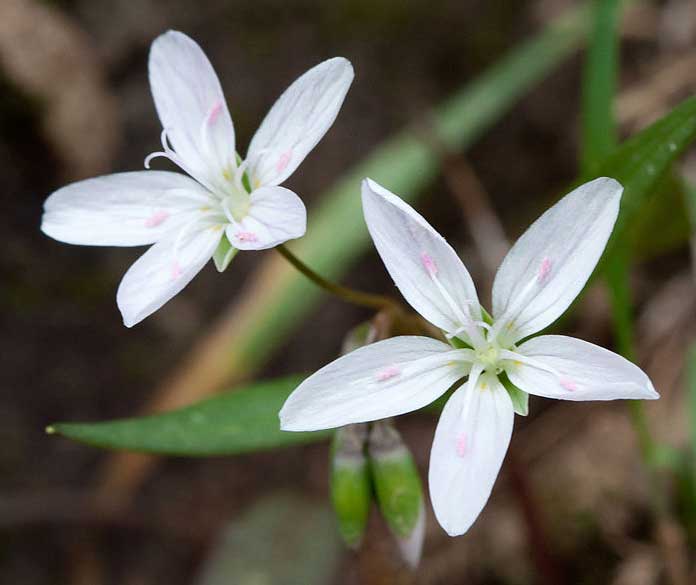
Claytonia virginica
Classification System: APG IV
Superregnum: Eukaryota
Regnum: Plantae
Cladus: Angiosperms
Cladus: Eudicots
Cladus: Core eudicots
Ordo: Caryophyllales
Familia: Montiaceae
Genus: Claytonia
Species: Claytonia virginica
Name
Claytonia virginica L.
References
Linnaeus, C. 1753. Species Plantarum. Tomus I: 204. Reference page.
USDA, ARS, Germplasm Resources Information Network. Claytonia virginica in the Germplasm Resources Information Network (GRIN), U.S. Department of Agriculture Agricultural Research Service. Accessed: 09-Oct-10.
Vernacular names
English: Eastern spring beauty, Virginia spring beauty, fairy-spuds
Claytonia virginica, the Virginia springbeauty,[1] eastern spring beauty, grass-flower[2] or fairy spud, is an herbaceous perennial in the family Montiaceae.[3] Its native range is eastern North America.[1] Its scientific name honors Colonial Virginia botanist John Clayton (1694–1773).
Description
Springbeauty is a perennial plant, overwintering through a tuberous root. It is a trailing plant growing to 5–40 cm (2–16 in) tall.[4] The leaves are slender lanceolate, 3–14 cm (1+1⁄4–5+1⁄2 in) long and 0.5–2 cm (0.20–0.79 in) broad,[4] with a 6–20 cm (2+1⁄4–7+3⁄4 in) long petiole.
The flowers are 0.7–1.4 cm (0.28–0.55 in) in diameter with five pale pink or white (rarely yellow) petals,[5] and reflect UV light.[6] It has a raceme inflorescence, in which its flowers branch off of the shoot. The individual flowers bloom for three days, although the five stamens on each flower are only active for a single day.[6] Flowering occurs between March and May depending on part of its range and weather. The seeds are between 0.2 and 0.3 cm (0.08 and 0.12 in) in diameter and a shiny black.[5] The seeds are released from the capsule fruit when it breaks open.[6] Elaiosomes are present on the seeds and allow for ant dispersal.[5]
It is a polyploid, having 2n between 12 and 191 chromosomes. The largest number of chromosomes was observed in New York City.[7][8]
Habitat and range
Springbeauty is found in the Eastern temperate deciduous forest of North America.[9] It is noted for its abundance throughout many parts of its range, especially in forests. The plant can be found throughout many different habitat types including lawns, city parks, forests, roadsides, wetlands, bluffs, and ravines.[5]
Hammond's yellow spring beauty
Hammond's yellow spring beauty, Claytonia virginica var. hammondiae, is a varietal with a very small range and population in a few areas of Northwestern New Jersey.[10][11]
Uses
This plant has been used medicinally by the Iroquois, who would give a cold infusion or decoction of the powdered roots to children suffering from convulsions.[12] They would also eat the raw roots, believing that they permanently prevented conception.[13] They would also eat the roots as food,[14] as would the Algonquin people, who cooked them like potatoes.[15]
Spring beauty corms along with the entire above ground portion of the plant are safe for human consumption.[16] The leaves can be cooked in salted water, although are not choice eating.[4]
References
USDA, NRCS (n.d.). "Claytonia virginica". The PLANTS Database (plants.usda.gov). Greensboro, North Carolina: National Plant Data Team. Retrieved 17 January 2016.
Britton, Nathaniel Lord; Brown, Addison (1913). An Illustrated Flora of the Northern United States, Canada and the British Possessions: From Newfoundland to the Parallel of the Southern Boundary of Virginia, and from the Atlantic Ocean Westward to the 102d Meridian. Vol. 2. C. Scribner's sons. p. 37. Retrieved 15 June 2018.
"Claytonia virginica L.". Tropicos. Missouri Botanical Garden.
Elias, Thomas S.; Dykeman, Peter A. (2009) [1982]. Edible Wild Plants: A North American Field Guide to Over 200 Natural Foods. New York: Sterling. p. 91. ISBN 978-1-4027-6715-9. OCLC 244766414.
Miller, John M. (2003). "Claytonia virginica". In Flora of North America Editorial Committee (ed.). Flora of North America North of Mexico (FNA). Vol. 4. New York and Oxford – via eFloras.org, Missouri Botanical Garden, St. Louis, MO & Harvard University Herbaria, Cambridge, MA.
Schemske, D.; Willson, M.; Melampy, M.; Miller, L.; Verner, L.; Schemske, K.; Best, L. (1978). "Flowering ecology of some spring woodland herbs". Ecology. 59 (2): 351–366. doi:10.2307/1936379. JSTOR 1936379.
Lewis, Walter H.; Oliver, Royce L.; Suda, Yutaka (1967). "Cytogeography of Claytonia virginica and Its Allies". Annals of the Missouri Botanical Garden. 54 (2): 153–171. JSTOR 2395001.
Miller, J. M.; Chambers, K. L. (2006). Systematics of Claytonia (Portulacaceae). Systematic Botany Monographs. Vol. 78. pp. 1–236. ISBN 0-912861-78-9.
USDA, NRCS (n.d.). "Claytonia virginica". The PLANTS Database (plants.usda.gov). Greensboro, North Carolina: National Plant Data Team.
Wright, Jim (June 4, 2015). "Yellow Spring Beauty: Meet the Rare Wildflower of New Jersey". Conservancy Talk. Nature Conservancy.
"Hammond's Yellow Spring Beauty" (PDF). New Jersey Natural Heritage Program Factsheet. Archived from the original (PDF) on 2015-06-10. Retrieved 2017-12-09.
Herrick 1977, p. 317.
Herrick 1977, p. 318.
Waugh, F. W. (1916). Iroquis Foods and Food Preparation. Ottawa: Canada Department of Mines. p. 120.
Black, Meredith Jean (1980). Algonquin Ethnobotany: An Interpretation of Aboriginal Adaptation in South Western Quebec. Mercury Series Number 65. Ottawa: National Museums of Canada. p. 84.
Thayer, Samuel (2006). The Forager's Harvest. Forager's Harvest. pp. 193–199. ISBN 0976626608.
Bibliography
Herrick, James William (1977). Iroquois Medical Botany (PhD thesis). Albany: State University of New York.
Retrieved from "http://en.wikipedia.org/"
All text is available under the terms of the GNU Free Documentation License

